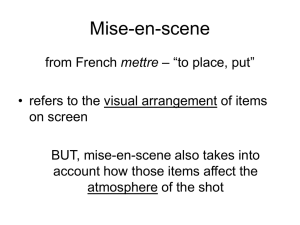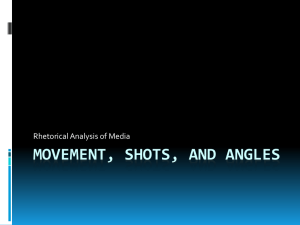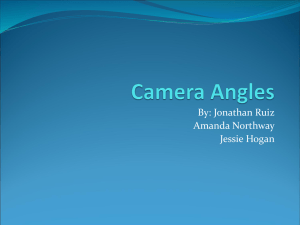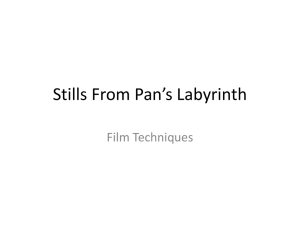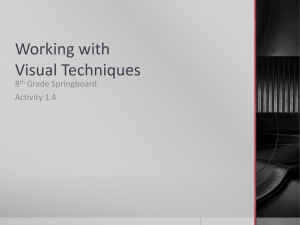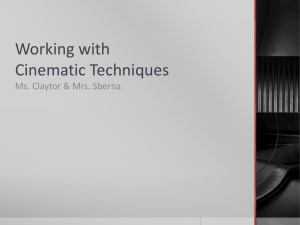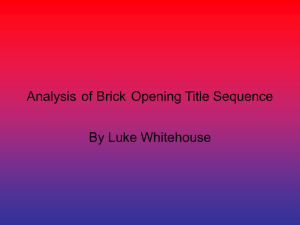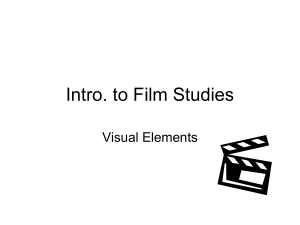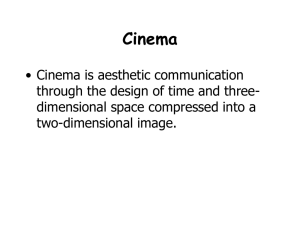Document
advertisement
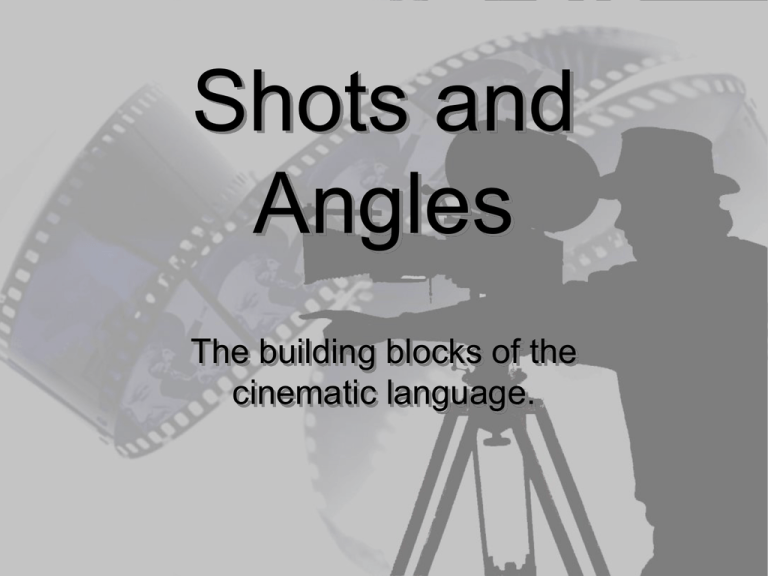
Shots and Angles The building blocks of the cinematic language. Camera Angle • The camera angle determines both the audiences viewpoint, or how they see the story, and the physical amount of area covered in a shot. 1. What is the viewpoint, or the story demands, for recording this portion of the event? 2. How much area should be included in the shot, in order to communicate the story? Both questions deal with the audiences perspective on what the story is. The camera angle is one of the most important factors in keeping the audiences interest. • Don’t “Jar” the camera - use a tri-pod or dolly. • Be sure to frame the shot appropriately • Maintain scene direction. • Be mindful of the rule of thirds. • Pay attention to the view finder. • Pay attention to the background. What are the four basic styles of film making? • Documentary -a journalistic style, recording of real events. Used to communicate an opinion or idea. • Narrative - general storytelling films. • Instructional- How to videos, to teach a subject. • Experimental - Film for film’s sake. using the camera, accessories or effects to gain a “new” approach or process to film making. All styles of video making are governed by the aesthetics of the director and the genre of film. Vocab • Aesthetics – adj. Concerned with beauty or the appreciation of beauty. Noun- A set of principles underlying and governing the work of a particular artist or artistic movement. • Genre – A category of artistic composition characterized by similarities in form, style and subject matter. • Cinema – The production of movies as an art or industry. The Building Blocks of Cinema. • Frame • Shot • Scene • Sequence The Frame • • • • • The smallest piece of information in film. A single still image in a series of images. NTSC - 29.97 Frames Per Second (fps) PAL - 25 fps Film - 24 fps The Shot • A shot defines a continuous camera take with out disruption. • May be referred to as a panel in pre-production storyboards. • May be referred to as a take, during production. • May be referred to as a clip in post-production, editing. The Scene • A scene defines the place or setting where the action is being filmed. • Each new place (setting) maybe a new scene. • Borrowed from theater. Where acts were broken down with different scenery or settings. The Sequence • A sequence is a series of scenes, or shots that complete a subject or idea. • A sequence may occur in a single setting (place), or in several settings (places). • A sequence ends when the subject matter changes. Camera Angles • Objective • Subjective • Point of View • High Angle • Low Angle • Dutch Angle • Low angle - Cats eye view – looking up at a character. Gives the audience a feeling that this person is powerful. Used to show the large scale of a character or object. • High angle - Birds eye view – from above the character used to make the character feel Inferior. Used to show the small scale of a character or object. • Dutch angle – when the cinematographer skews the vertical axis to give an exciting or an uneasy feeling, this will help to show character in an altered state of reality from being tired, loony or uppity or narcissistic and high strung. Objective camera angle • When the audience views what is happening as an unseen observer. • The audience feels as though they are eaves dropping on the characters in the scene. • Objective camera angles are impersonal. • The players in a scene are unaware of the camera and never make eye contact.When filming an objective camera angle if any person in the scene looks into the camera the shot is ruined and will need a re-take. Subjective camera angle • Involves the audience directly with the characters in the scene. • Players may look directly into the camera. • Camera acts as the players eyes. Point of View • A point of view shot is when the camera angle records the scene from a particular point player’s point of view. • A point of view shot is as close as an objective shot can be with out being a subjective shot. • In a point of view shot the camera is positioned “cheek to cheek” with a character. P.O.V.’s are often followed by (O.T.S) over the shoulder shots during dialog exchange. Vocab • Cutaway – A Shot that is not a key element in the action, commonly used to bridge what would be a jump cut. • Jump Cut – A shot that constitutes an error in editing which result in an on-screen object or character appearing to jump positions. • Headroom – The amount of room between the top of a players head and the top of the viewfinder or frame. SHOTS Extreme long shot (ELS or XLS)– shows a vast area from a great distance. Also know as a wide shot. Long shot (LS)– a take of the entire action of a scene. A shot that sets ups the scene and gives a general feel for the event. • Entrance and exits of characters, cars, planes. Establishing shot (EST)– this is a camera shot that sets up what is about to take place. This is usually a sequence starting point. Medium Shot (MS)– falls between the long shot and a close up. Normally from the Waist to just over the head. Also know as a mid shot. • Involves the audience a little more closely to the action at hand. May involve more than one character. Close up (CU)– just below the shoulders to above the head. Also know as a tight shot or a narrow shot. Choker – Is from just above the eyebrow to just below their chin. Used in an exclamatory way, to show the expression of a face or to simply show a persons face to help identify a character. • You can cut off a persons forehead but not their chin. Extreme Close up (ECU or XCU)- a very close view of a particular body part or part of an object. Inserts – A full screen shot of descriptive information that helps to clarify a scene. i.e.- full screen shots of letters, clock faces, cannon fuses. Panorama (Pan) –positioned on a vertical axis, the camera rotates left to right or right to left. Tilt - Positioned on a horizontal axis and the camera rotates up and down or down and up. Two Shot – a.k.a. the American shot, any shot that bring two sides to a confrontation. • Boy and girl meets. • Hero vs. the villain. • It could even be one group of people against another. • May also simply be two people in one shot. Three shot – involving three characters in one shot. Group Shot – includes more than three characters. Camera Moves • Dolly (in / out)- Physically moving the camera, it’s tri-pod, and dolly towards or away from the set. • You can dolly in or dolly out • Truck (left / right)- Physically moving the camera, it’s tri-pod, and dolly left or right parallel to the set. • You can Truck right or Truck left • Pedestal (up / down)- Raising or lowering the camera on the tripods pedestal column while the tripod remains stationary. • You can Pedestal up or down. • Arc (left / right)- Moving the camera in a curved motion around the set while the camera stays fixed on an object or character. • You can arc right or arc left • Tracking– is when the camera is on a track or with a dolly, or on a cable and follows the action of a shot.
